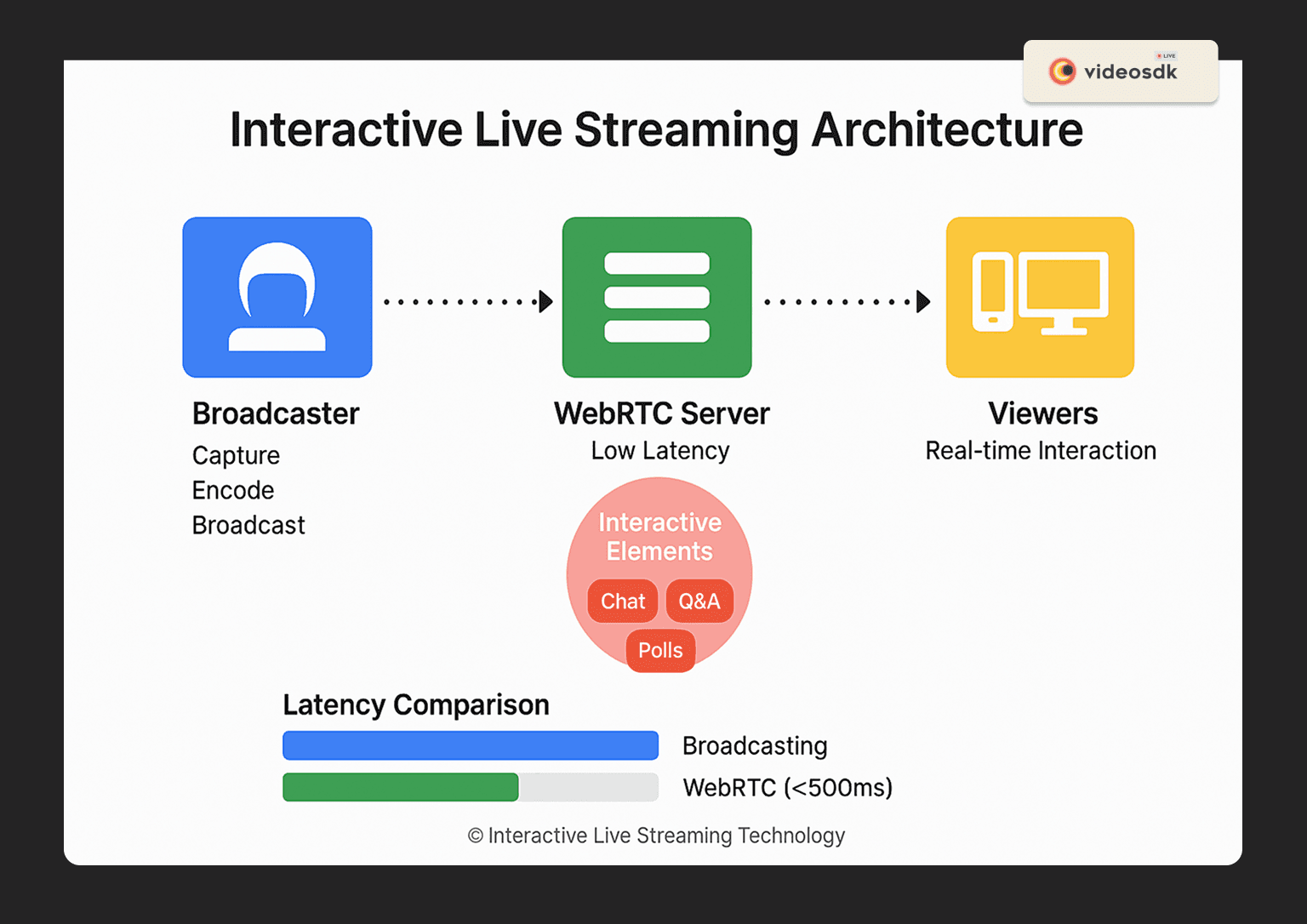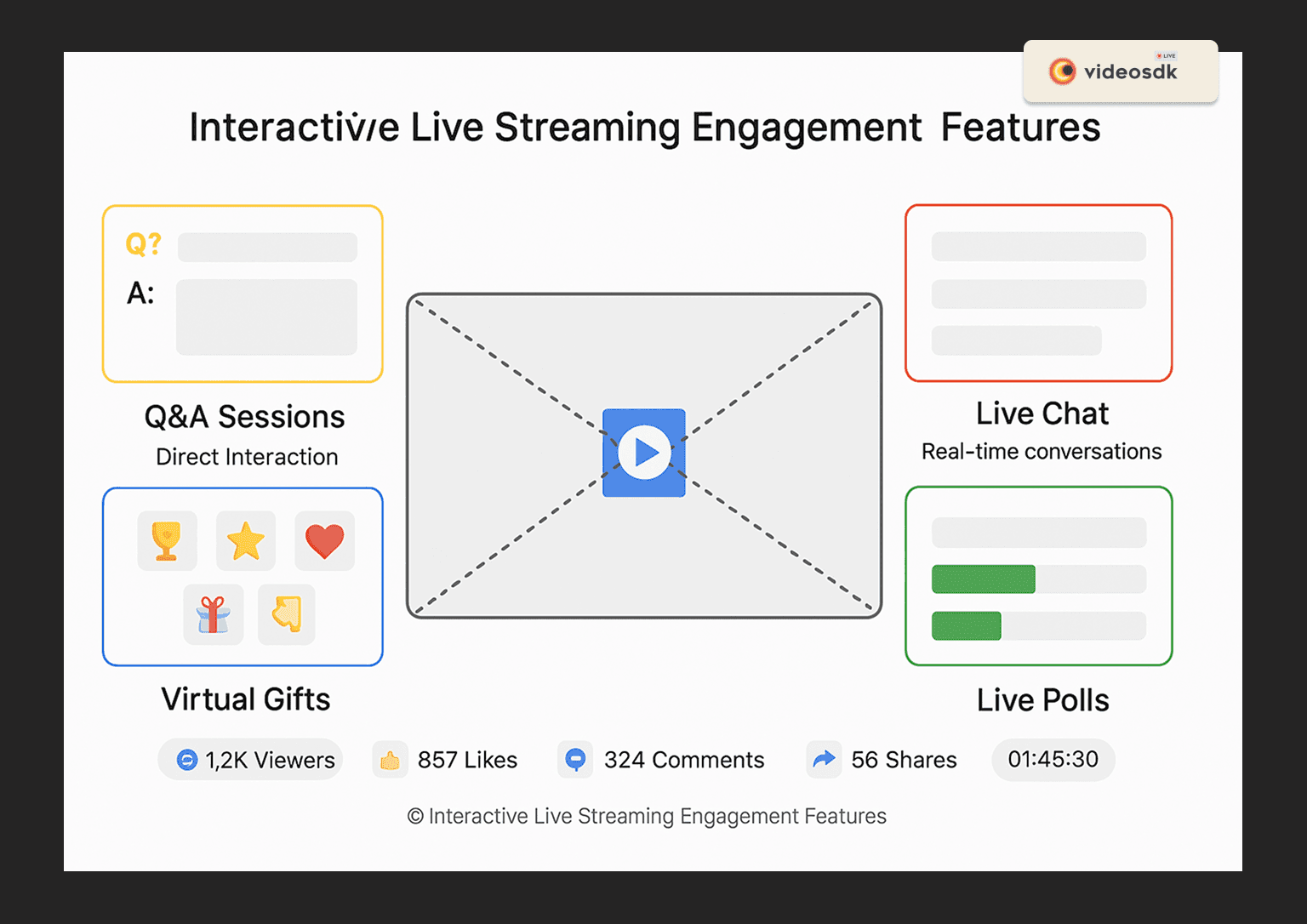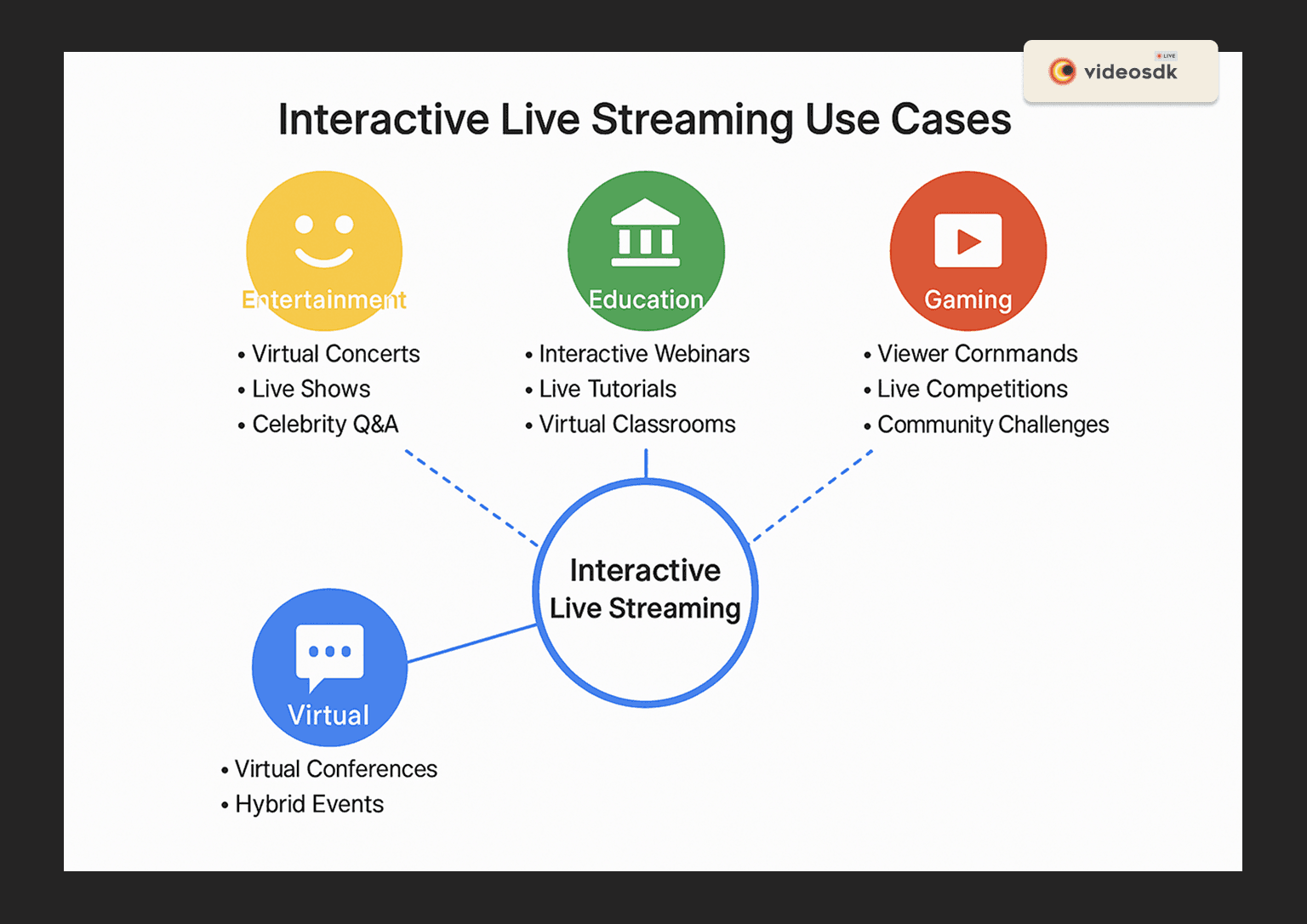Interactive Live Streaming: The Ultimate Guide to Engaging Your Audience
Learn how interactive live streaming is revolutionizing digital engagement through sub-second latency and real-time audience participation. This guide covers everything from WebRTC technology and essential equipment to monetization strategies and implementation best practices.
For years, HTTP Live Streaming (HLS) has dominated video delivery online, offering reliable playback but with significant latency issues—often 15-30 seconds of delay. This lag made real-time interaction between creators and audiences virtually impossible, limiting engagement to passive viewing experiences.
Enter interactive live streaming: the next evolution in video broadcasting technology. By leveraging protocols like WebRTC that reduce latency to sub-second levels, interactive streaming enables genuine real-time engagement. Viewers can actively participate in polls, receive immediate responses to questions, and directly influence content as it's being created.
This guide explores how interactive live streaming is transforming digital communication, its technical foundations, and how you can implement it to build more engaging, dynamic audience experiences.
What is Interactive Live Streaming?
Interactive live streaming goes beyond traditional broadcasting by enabling real-time engagement between the streamer and viewers. Unlike conventional streaming where viewers passively watch content, interactive streaming transforms the audience into active participants who can influence the content, ask questions, respond to polls, and even appear on screen.
This two-way communication creates a dynamic environment where viewers feel genuinely connected to the content creator and other audience members. For content creators, this interactivity builds stronger relationships with viewers, increases retention, and opens new monetization opportunities.
How Interactive Live Streaming Works: The Technical Aspects
The Basic Process: Capturing, Encoding, and Broadcasting
Interactive live streaming involves several technical steps:
- Capture: Video and audio are captured through cameras, microphones, and screen recording.
- Encoding: Raw audio/video data is compressed into streamable formats.
- Broadcasting: The encoded stream is transmitted to a streaming server or CDN.
- Distribution: The stream reaches viewers' devices through content delivery networks.
- Playback & Interaction: Viewers watch and engage through interactive elements.

Key Technologies: WebRTC and Low-Latency
The technology powering truly interactive experiences is WebRTC (Web Real-Time Communication), which enables ultra-low latency communication. While traditional streaming might have delays of 10-30 seconds, WebRTC can achieve sub-second latency, making real-time interactions possible.
Content Delivery Networks (CDNs) complement this technology by distributing the stream globally, ensuring viewers from different regions experience minimal buffering and consistent quality.
Essential Equipment and Software
To create professional interactive live streams, you'll need:
- Computing device: A PC or laptop with sufficient processing power
- Broadcasting software: OBS Studio, Streamlabs, or specialized streaming platforms
- Camera: High-quality webcam or dedicated video camera
- Microphone: External microphone for clear audio
- Lighting: Proper lighting setup to ensure visibility
- Stable internet connection: Preferably wired, with sufficient upload bandwidth
The Benefits of Interactive Live Streaming
Enhanced Engagement and Community Building
Interactive elements transform passive viewers into active participants, significantly increasing engagement rates. Features like live chat, polls, Q&A sessions, and on-screen viewer recognition create a sense of community and belonging. This community-focused approach leads to higher retention rates and longer watch times.

Increased Accessibility and Reach
Live streaming breaks down geographical barriers, allowing content to reach global audiences simultaneously. Adding interactive elements makes content more accessible to diverse audience segments and enables real-time translation and closed captioning for viewers with different needs.
Monetization Opportunities
Interactive live streaming opens multiple revenue streams:
- Virtual gifts and donations from viewers
- Subscription models for premium content
- Sponsored content and brand partnerships
- Live shopping with real-time purchasing
- Pay-per-view events with interactive features
Improved Brand Loyalty and Conversions
For businesses, interactive live streaming builds trust through authentic, unfiltered communication. When customers can ask questions and receive immediate responses, it creates transparency that fosters brand loyalty and drives conversions.
Interactive Live Streaming: Real-World Examples and Use Cases

Concerts and Live Performances
Artists increasingly use interactive live streaming to connect with fans worldwide. Virtual concerts with chat features, song requests, and virtual meet-and-greets create immersive experiences that complement traditional in-person events.
iGaming and Sports Betting
Live dealer casino games and sports betting platforms leverage interactive streaming to create engaging experiences. Players can interact with dealers in real-time, place bets during live sports events, and communicate with other participants.
Webinars and Online Tutorials
Educational content benefits tremendously from interactivity. Instructors can gauge understanding through polls, answer questions in real-time, and adapt content based on viewer feedback, creating a more effective learning environment.
Live Shopping and Auctions
E-commerce brands use interactive live streaming to showcase products, demonstrate features, and allow instant purchasing. Similarly, auction houses create excitement through live bidding, where participants can see competing bids in real-time.
Gaming
Gaming streams on platforms like Twitch thrive on interactivity. Viewers can influence gameplay through chat commands, donate to trigger special effects, and participate in community challenges, creating unique entertainment experiences.
Tips and Strategies for Creating Engaging Interactive Live Streams
Understanding Your Audience
Before going live, research your target audience to understand their preferences, pain points, and engagement patterns. Choose the right platform based on where your audience is most active and what interactive features they value.
Planning Your Content and Talking Points
Prepare a flexible structure with clear talking points to guide your stream. Identify natural moments for interactive elements like polls, Q&A sessions, or viewer challenges. Create a balanced mix of planned content and spontaneous interaction.
Optimizing Visual and Audio Quality
Invest in quality equipment and ensure proper setup:
- Test lighting to eliminate shadows and ensure visibility
- Position microphones to capture clear audio without background noise
- Create a professional or branded background
- Run technical tests before going live
Incorporating Interactive Elements
Strategically include features that encourage participation:
- Live chat with moderation for community discussions
- Polls and surveys to collect opinions and guide content
- Interactive overlays displaying viewer information and activities
- Multi-view options for different perspectives
- Viewer-triggered effects or animations
Key Takeaways
- Interactive live streaming transforms passive viewers into active participants
- Low-latency technologies like WebRTC enable true real-time interaction
- Benefits include increased engagement, community building, and monetization
- Successful streams require planning, quality production, and strategic interactive elements
- Understanding your audience is crucial for selecting the right platform and features
Conclusion
Interactive live streaming represents the future of digital content, blending the immediacy of live video with the engagement of social media. As technology continues to evolve, we can expect even more immersive interactive features that blur the line between content creators and consumers.
Whether you're a business looking to connect with customers, an educator reaching students, or a content creator building a community, interactive live streaming offers unprecedented opportunities to engage, inform, and entertain your audience in meaningful ways.
Want to level-up your learning? Subscribe now
Subscribe to our newsletter for more tech based insights
FAQ